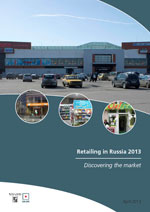 | Retailing In Russia 2013 - Discovering The MarketRelease date: April 9th, 2013 (51 pages) PDF/Powerpoint format. Price: GBP990.00 |
Abstract
Russia represents a large middle-income market with growing consumer
expenditure. The retail industry in Russia is in a good position as one of the
fastest growing industries in terms of value added. It is in the process of
consolidation with top national and regional chains generally outperforming
internationally experienced entrants in terms of revenue, profits, and the
number of stores.
Yet, doing business in Russia is perceived as rather complicated, so the
combination of market opportunities, entry barriers, and risks creates a truly
strategic puzzle. This report helps understand the trends and peculiarities
of the Russian business environment focusing on retail, one of the most
competitive, consumer-driven markets.
Rich in exclusively available data from executive surveys and corporate
strategies, this report
• presents key retail statistics with comments regarding possible
misinterpretations of the publicly available data
• summarises data for top retailers such as revenues, selling space,
and a P&L account
• highlights trends in shopping and consumer behaviour that are
specific to the Russian market
• describes four distinct winning strategies being implemented by the
Russian retailers
• suggests how to reduce exposure to adverse conditions of doing
business in Russia whilst enjoying its market opportunities
Table of contents
| 1. IntroductIon 3 2. the economy 4 3. economIc geography and demography 7 4. the retaIl Industry 12 4.1. Retail is one of the fast and steadily growing industries 12 4.2. Together with the food industry, retail leads M&A 13 4.3. The number of newly opened production facilities, while small, started increasing 13 4.4. Retail in Russia compared to developed markets (what executives say) 14 5. What a foreIgn retaIler or a supplIer mIght expect from the russIan market 15 6. consumer market trends 17 6.1. Internet is becoming the main communication and transaction channel 17 6.2. The values and habits of new generations increasingly influence both consumption and employment 19 6.3. Changing the way consumers shop 21 6.4. Inflation of brands 22 6.5. Growing niche demand and consumer market fragmentation 22 6.6. Increasing demand for fast food 24 7. retaIler types and strategIes 25 7.1. Retailer types 25 7.2. Some history 25 7.3. External risks and threats 26 7.4. Typical strategies 2012-2016 28 7.5. Strategic priorities 33 8. key elements of the strategIes 34 8.1. Choosing the town and the expansion path 34 8.2. Choosing store location within the town 35 8.3. Consumer engagement 37 8.4. Category management and contracting with suppliers 39 8.5. Private labels 41 8.6. Managing incoming and in-store logistics 43 8.7. Promotional activities 44 8.8. Accounting for seasonality 45 9. selected performance IndIcators 46 9.1. Top-100 retailers 46 9.2. P&L account of a typical regional store 47 Table 1. Key statistics Table 2. Consumer price index and basic tariffs Table 3. Top 10 regions by natural increase and decrease Table 4. Cities with more then 1 mln citizens Table 5. Urban vs. Rural Table 6. Major agglomerations Table 7a. Market size by types of retailers, $ mln Table 7b. Market size by types of retailers – percentage dynamics Table 8. Retail space Table 9. Industries and growing perspectives Table 10. Acquisitions by industry Table 11. Number of newly opened production facilities, by industry Table 12. Share of retail revenues generated via internet channel Table 13. The revenue structure of online retailers Table 14. The largest internet retailers in Russia Table 15. Criteria defining the people-21 Table 16. What kind of activities do consumers do on a regular basis? Table 17. Top cities (upper the average for Russia) the people-21 Table 18. Product purchased by a fan and fans’ market share Table 19. Organic consumption Table 20. Price differences organic vs regular Table 21. Risks and impact Table 22: Aniks Group franchising business model Table 23: Top priorities for retailers - 2013/2014 Table 24: Parameters and criteria for choosing a place Table 25. What makes a consumer return to a shop more than twice? Table 26. Most popular loyalty schemes in Russia Table 27. Private labels Table 28. Most frequently used promotional actions Table 29. Top-10 retailers by the revenue per sqm of the selling square (2011) Table 30. Retailers grown by 40+% in 2011 (of the top-100 retailers) Table 31. Retailers by format Figure 1. Age structure change by 2020 (compared to 2012) Figure 2. GDP and population in the Russian Federation Figure 3. An example of segmentation for a grocery store Figure 4. How many stores do you shop Figure 5. Distribution of revenue per sqm ($ ‘000) |
